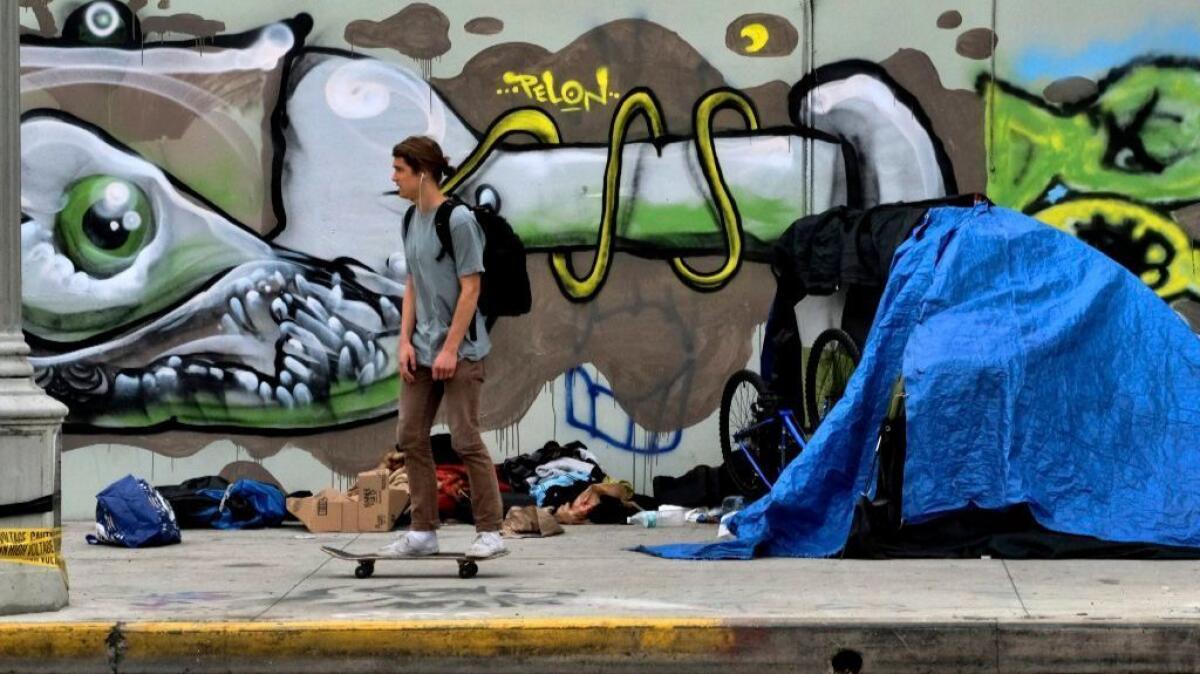Op-Ed: We’re working on the homeless problem, but don’t expect instant results

No one in Los Angeles was surprised to hear on Wednesday that the homeless population had ballooned yet again. Everywhere one looks one sees people sleeping on sidewalks, in tents and recreational vehicles. The homeless are now a part of our urban and suburban landscape. But there’s no reason to despair, as long as we moderate our expectations.
Since 2013, the number of homeless in Los Angeles County has increased from more than 35,000, to 44,000, then to 47,000, and now to nearly 58,000, according to the latest count. What’s especially vexing is that this jump comes after years of regional initiatives to end homelessness.
Twenty years ago, I joined a Westside homeless agency called People Assisting the Homeless, or PATH, that in the 1990s provided transitional housing and employment training as solutions to the region’s homelessness problem. Back then, my co-workers and I thought we could solve homelessness within five years. Obviously we were wrong.
In 2004, the city of Los Angeles created a Blue Ribbon Panel to end homelessness within the next decade called Bring LA Home. (I was a member). The panel consisted of more than 60 political, corporate, nonprofit and faith leaders. Mayor Eric Garcetti was on the panel as a city councilman.
This group of smart, strategic and influential people concluded that for Los Angeles to end homelessness, it would have to invest $1.5 billion per year for 10 years, a price tag that doomed the initiative.
Predictably, homelessness continued to rise.
After local businesses, neighborhood groups and compassionate people inundated their elected officials with complaints about homelessness, city and county leaders courageously promoted and got passed Proposition HHH (an L.A. City initiative that provides $1.2 billion to build 10,000 units of housing for people who are homeless) and Measure H (an L.A. County resource that will provide $3.55 billion of homeless services in the next 10 years).
I support these initiatives, but we shouldn’t repeat the mistake we’ve made in the past of thinking that we can end homelessness right away.
Homelessness in Los Angeles is caused by the confluence of the skyrocketing price of housing and wage stagnation, which means workers don’t earn enough to afford housing. The average rent for a one-bedroom apartment is $1,930 per month, and according to Zillow.com, a person would need to earn $57,000 per year to afford it.
What this math means is that to reduce the number of homeless, we need to build more housing that is affordable for average wage earners and that provides support services for people who have been chronically homeless.
This is the justification for HHH and H, but it will take years, not months, to build 10,000 housing units. What we’re creating is a housing infrastructure that will only reduce homelessness, rather like public transit infrastructure reduces but does not resolve the problem of congestion on our roads.
We have to keep things in perspective.
Just as we see new rail connections as signs that we are addressing our traffic issue (even as we continue to get stuck on the freeway) we should see new permanent supportive housing apartment buildings as signs that our region is seriously addressing its homelessness issue (even as we continue to see tents on overpasses). For a while, at least, that may be all the evidence we have.
Even though this year’s homeless numbers increased, we should remain hopeful.
Joel John Roberts is the CEO of PATH and PATH Ventures, L.A.-based homeless services and housing development agencies with locations throughout California.
Follow the Opinion section on Twitter @latimesopinion or Facebook
More to Read
A cure for the common opinion
Get thought-provoking perspectives with our weekly newsletter.
You may occasionally receive promotional content from the Los Angeles Times.










